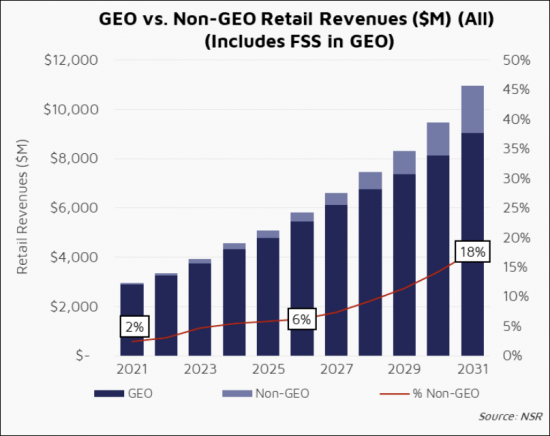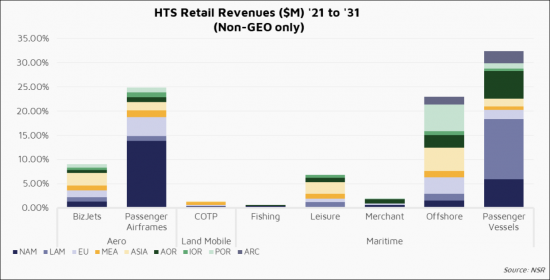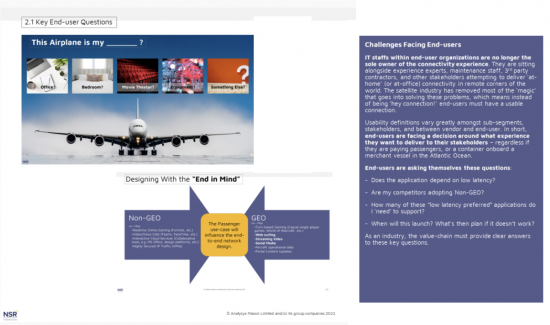 |
市場調查報告書
商品編碼
1108739
Leo及Meo寬頻衛星行動性市場Leo & Meo Broadband Satellite Mobility Markets |
||||||
Leo及Meo寬頻衛星行動性,有帶給海洋與其他未連接的地區大容量的可能性,從寬波束FSS架構,轉移到點束GEO-HTS基礎設施顛覆傳統以GEO為中心的市場。

本報告提供Leo及Meo寬頻衛星行動性市場相關調查,商業航空,陸上移動,海上運輸的各終端用戶的非GEO-HTS連接的機會評估,終端用戶的採用和促進來自現有的GEO為基礎的解決方案的轉移的主要原因,進入到該市場的LEO及MEO HTS供應商等資訊提供。


目錄
摘要整理
第1章 行動性市場上非GEO狀況
- LEO的檢討
- 主要的非GEO HTS企業
- 供給影像
第2章 市場課題
- 主要的終端用戶的問題
- 服務供應商範例
- 衛星運用者的困境
第3章 行動性市場預測
- 各軌道及子市場區隔:零售收益
- 各地區:非GEO HTS零售收益
- 運作中的單位
- 各軌道及市場區隔:HTS容量的需求
- 結論
Report Summary:
NSR's “LEO & MEO Broadband Satellite Mobility Markets report (LMBSMM) ” assesses the 'big question' faced by the satellite communications industry today- what is the impact of current or emerging Non-GEO HTS satellite constellations? NSR's “LMBSMM” provides recommendations for service providers, and satellite operators to understand key messages resonating most with end-users to help improve their market positioning.
NSR's “LEO & MEO Broadband Satellite Mobility Markets report (LMBSMM) ” offers a detailed analysis of both LEO and MEO orbits using Ku and Ka-bands. These systems by their global nature have the potential of bringing significant capacity to oceans and other traditionally under-connected regions - disrupting a traditionally GEO-centric market that is still undergoing a transition from wide-beam FSS architectures to spot-beam GEO-HTS infrastructure.
Overall, NSR's “LMBSMM” provides business-critical insights and analytics for the how, where, and why of these LEO & MEO options and their influence on the 10-year outlook for Ku- and Ka-band Broadband Mobility Markets.

This Report does not answer the question of "LEO viability", nor does it provide specific market shares or projections around each of these leading Non-GEO HTS constellations. While these are other key considerations around the Non-GEO HTS market, those questions are answered elsewhere in NSR's library of research.
Who Should Purchase this Report:
- Investors looking to understand and spotlight impacts or opportunities for LEO & MEO services in commercial mobility end-user segments
- Investors and financial institutions
- End-users looking to benchmark their current connectivity roadmaps
- Strategy, planning and business intelligence teams with satellite operators
- Product or vertical managers at Satellite Service Providers
- Satellite manufacturers and integrators
- Data analytics companies
- Distributors, Service Providers, Retailers and Resellers of Satellite Services
- Network Operators
Key Features:
Covered in this Report:
- Assesses the opportunity for Non-GEO-HTS connectivity from commercial Aeronautical, Land-Mobile, and Maritime End-users
- Examines the key factors driving end-user adoption and/or migration from exiting GEO-based solutions
- Highlights the key LEO & MEO HTS providers approaching this market
- Analysis of the LEO & MEO HTS provider path to market
- Evaluates the where, when, and how of GEO keeping competitive in the longer term
- Compiled viewpoint of the commercial mobility opportunity from an In-Service unit, Capacity Demand and Revenue component, split by each mobility end-user segment (Aero, Land, Maritime)


Table of Contents
Executive Summary
1. State of Non-GEO in Mobility Markets
- 1.1. LEO Review
- 1.2. Key Non-GEO HTS Players
- 1.3. Supply Picture
2. Market Challenges
- 2.1. Key End-user Questions
- 2.2. Service Provider Paradigm
- 2.3. Satellite Operator Dilemma
3. Mobility Market Forecasts
- 3.1. Retail Revenues by Orbit and Sub-Segment
- 3.2. Non-GEO HTS Retail Revenues by Region
- 3.3. In-Service Units
- 3.4. HTS Capacity Demand by Orbit and Segment
- 3.5. Bottom Line













